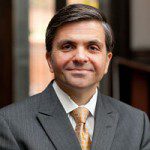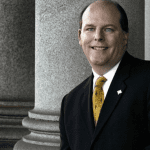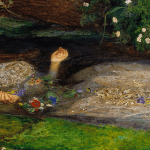A guest post from my friend Mark Goldblatt, about the night that changed the American music scene forever.
*
By Mark Goldblatt
Fifty years ago this week, on February 9th, 1964, the Beatles made their first appearance on the Ed Sullivan Show. I was six years old and don’t remember much of it, but my mother never tired of telling the story of what happened that night in the Goldblatt household.
We owned one television, a black and white Motorola monster built into a battleship of walnut cabinetry which also housed a record player, a radio tuner and hi-fi speakers. My five year old sister and I functioned as remote controls for my father, who, when he was home, would lie on the living room couch and exercise absolute dominion over programming. The arrangement was more onerous than you’d think; it meant that wherever we were in the house, whatever we were doing, if my dad wanted to change channels, one of us had to run into the living room to do it.
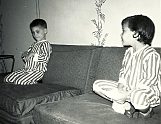 The payoff for our labors came each Sunday night, at eight o’clock, when we’d gather around the TV — my mom and dad on the couch, my sister and I on the pine green carpet at their feet — for Ed Sullivan. It was the only program we watched together, a coincidence of agendas: My dad liked the show enough to watch it straight through, my mom liked the idea of the family together at the end of the weekend, and my sister and I liked staying up past our usual 7:30 bedtime. On a typical Sunday night, according to my mom, my sister would last until 8:15; I’d start to doze off fifteen minutes later. By 8:45, we’d both be conked out on the carpet, ready to be toted to the bedroom we shared as soon as Sullivan signed off at 9:00.
The payoff for our labors came each Sunday night, at eight o’clock, when we’d gather around the TV — my mom and dad on the couch, my sister and I on the pine green carpet at their feet — for Ed Sullivan. It was the only program we watched together, a coincidence of agendas: My dad liked the show enough to watch it straight through, my mom liked the idea of the family together at the end of the weekend, and my sister and I liked staying up past our usual 7:30 bedtime. On a typical Sunday night, according to my mom, my sister would last until 8:15; I’d start to doze off fifteen minutes later. By 8:45, we’d both be conked out on the carpet, ready to be toted to the bedroom we shared as soon as Sullivan signed off at 9:00.
February 9th, 1964 was different however. My mom said that you could sense it from the start of the show. There was a buzz in the studio audience that came through the speakers and seemed to take hold of me and my sister. We were suddenly up on our haunches — as skittish, she said, in her Louisiana twang, as long-tailed cats in a room full of rocking chairs. She had just enough time to notice the difference before Sullivan introduced the Beatles, and the crowd broke into a torrent of screams…at which point, my sister and I rushed the TV. The two of us sat mesmerized, perhaps a foot from the screen, as Paul McCartney began to sing, “All My Loving.” We did not move the entire hour, not even during the commercials. Afterwards, when my mother tried to tuck us into our beds, we kept kicking the covers loose. She got us settled down after a half hour. But around midnight, she was awakened by several loud thuds. She ran into our room and found us jumping up and down on our beds, literally bouncing off the walls, making nonsensical noises that sounded vaguely like Beatles songs.
It’s difficult for baby boomers to convey to their children, and now to their grandchildren, the utter otherness of the Beatles. There was, of course, the sheer enormity of the phenomenon. Beatlemania was a kind of collective derangement, an abrupt skewing of popular perception. By April, the group held down the top five positions on the Billboard Magazine chart with “Can’t Buy Me Love,” “Twist and Shout,” “She Loves You,” “I Want to Hold Your Hand” and “Please Please Me.” They had seven other songs in the Billboard’s Top 100. That meant that if you turned on a radio in the Spring of 1964, you heard a Beatles song. I recall thinking that the Motorola tuner was a Beatles music player; I recall, or at least seem to recall, turning it on once and hearing Louis Armstrong singing “Hello Dolly”… and thinking the thing was broken.
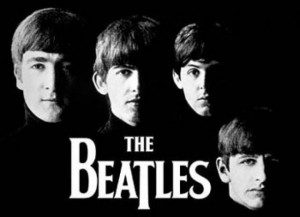 But Beatlemania went beyond radio airplay. The girls in my first grade class would sing Beatles songs as they lined up in the schoolyard, then break into spontaneous screams until the teachers shushed them. I remember a boy named Andrew crying in the back of the classroom because his mother made him cut his hair, which he’d wanted to grow out like the Beatles. My best friend, Eddy, a year older than I was, convinced his parents to buy him a Beatles single — I’m almost sure it was “A Hard Day’s Night.” I remember going over to his house and staring at it. Not playing it. That was too risky. Just staring at it, the paper sleeve and record together…and then, holy of holies, the vinyl itself. Eddy set it down on the pillow of his bed, and the two of us stepped back and venerated it.
But Beatlemania went beyond radio airplay. The girls in my first grade class would sing Beatles songs as they lined up in the schoolyard, then break into spontaneous screams until the teachers shushed them. I remember a boy named Andrew crying in the back of the classroom because his mother made him cut his hair, which he’d wanted to grow out like the Beatles. My best friend, Eddy, a year older than I was, convinced his parents to buy him a Beatles single — I’m almost sure it was “A Hard Day’s Night.” I remember going over to his house and staring at it. Not playing it. That was too risky. Just staring at it, the paper sleeve and record together…and then, holy of holies, the vinyl itself. Eddy set it down on the pillow of his bed, and the two of us stepped back and venerated it.
Back in 1964, of course, no one could have predicted that John Lennon, Paul McCartney, George Harrison and Ringo Starr would turn out to be much more than the phenomenon of Beatlemania, much more even than the sum of their talents, that by the end of the decade they’d bear that same clearly-within-yet-curiously-beyond relationship to popular music that Shakespeare bore to the English drama of his time. The tropes remain recognizable. But just as there is no explicable way to get from Nicholas Udall’s Ralph Roister Doister to Shakespeare’s A Midsummer Night’s Dream, so too there is no way to get from Elvis Presley’s “Jailhouse Rock” or Little Richard’s “Tutti Frutti” to Lennon’s “Revolution” or McCartney’s “Helter Skelter.” Think about it for a moment. Given the landscape of musical influences available to the Beatles, what’s the logical precedent for “Eleanor Rigby” or “I Am the Walrus” or “Golden Slumbers” or “Nowhere Man” or “Penny Lane” or “Across the Universe” or the entire Sgt. Pepper’s album? The question that jumps to mind with each of these recordings is: Where the hell did that come from?
It’s a question almost never associated with popular music. The stock-in-trade of popular music, by definition, is the familiar—from Bing Crosby and Frank Sinatra and Judy Garland to Hank Williams and Elvis and Ray Charles to Bob Dylan and the Rolling Stones and the Temptations to Creedence Clearwater Revival and Stevie Wonder and Bruce Springsteen to Michael Jackson and Madonna and U2 to (I suppose) Eminem and Mariah Carey and Beyoncé. (Forgive me if I’ve left out your favorite.) For each of them, there’s a traceable progression to their musical development, a causal relationship with what came before. What set the Beatles apart from the lineage was that they seemed to conjure their greatest work out of the ether — or maybe out of the breath of a muse. Consider the first verse of “For No One”: “Your day breaks, your mind aches/You find that all her words of kindness linger on/When she no longer needs you.” The subject matter couldn’t be more familiar — in essence, breaking up is hard to do. But the mood is Thomas Hardy. The compactness is William Carlos Williams. The rhythms and internal rhymes are Emily Dickinson, with hints of Dylan Thomas and Gerard Manley Hopkins. Now consider that the words are by McCartney, who was 23 at the time, who set out to write a pop song, not a work of literature, and who, by his own admission, never put as much effort into his lyrics as Lennon did.
When asked once whether he himself was a genius, Lennon replied, “Yes, if there is such a thing as one, I am one.” Whether Lennon was correct is debatable. He was no intellectual giant. “Imagine” is melodic and moving, especially given what we know of his fate, yet it’s as trite and grandiose as a greeting card. His inability to see through Yoko Ono’s bluff art is forgivable perhaps as the indulgence of a husband, but not otherwise. On the other hand, Lennon did have flashes of exquisite clarity throughout his life, even towards the end, as in the justly celebrated line from “Beautiful Boy”: “Life is what happens to you while you’re busy making other plans.” He also had a largeness of sensibility which both reflected and shaped the times in which he lived. Does that amount to genius?
The question of genius becomes less debatable when asked collectively of the Beatles: If there’s such a thing, they had it in spades. Indeed, the strongest evidence of their collective genius is found in the post-Beatle trajectories of Lennon, McCartney, Harrison and Starr. The consensus that none of them ever achieved the artistic levels they had in their twenties seems right. Nor can the case be made that what was lacking was collaboration with the others since many of their greatest songs had been written alone even during their Beatles years. What’s the likelihood of four artistic flameouts in their early thirties? To be sure, each had his moments after the breakup: Lennon with “Instant Karma,” McCartney with “Maybe I’m Amazed,” Harrison with “What Is Life?” and Starr (with Harrison’s help) with “It Don’t Come Easy.” But it’s worth noting that their finest solo work came in the afterglow of their Beatles lives, before the genius, or pixie dust, or whatever it was, had quite worn off. Afterwards, each receded into the hubbub of more-terrestrial talents. Lennon, who’d once seemed an unimaginable amalgam of Jonathan Swift, Lewis Carroll, Buddy Holly and Howlin’ Wolf, devolved into Lenny Bruce with a guitar and a howling Oedipal Complex. McCartney, who, as a Beatle, seemed to channel George Gershwin as often as Chuck Berry, became just another Brill Building-caliber singer-songwriter, a harder-edged Neil Diamond. Harrison, who’d developed into a great songwriter through osmosis, and who, for at least the period of “White My Guitar Gently Weeps,” “Something,” and “Here Comes the Sun,” could be ranked high in the rock pantheon, if not with Lennon and McCartney themselves, released one magnificent solo album, All Things Must Pass, consisting primarily of a backlog of Beatles-era material…and then a string of ever-more unlistenable records before hooking up with fellow has-beens including Dylan and Roy Orbison to form the intermittently palatable Traveling Wilburys. Starr, after the initial success of his solo album Ringo, went on to become a nostalgia act, even now peppering his stage performances and interviews with two-fingered peace signs straight out of 1970.
Clearly, in the case of the Beatles, the whole was greater than the sum of the parts.
But isn’t that a hopeful sign for the human condition? There’s a potential in each one of us, perhaps, for greatness — a potential that cannot be gauged or accounted for, a potential that cannot be tapped by social engineering because the formula for its realization is too mysterious. (What would a happy childhood, a structured adolescence and a formal musical education have done to John Lennon?) Of course, the overwhelming majority of us will never be truly great at anything. But the potential for greatness, even if it’s rarely realized, is the first and final counterargument to the grim sterility of materialism. We’re more, the Beatles remind us, than the cells of our bodies, more than the atoms of our cells, more than our drives and appetites, more than our economic relation to the state and to one another.
Under just the right circumstances, we can transcend the deterministic logic of what we are and come to the rarefied truth of why we are. Being the Beatles was the why of Lennon, McCartney, Harrison and Starr’s lives. It was their raison d’être, their teleology, their lasting contribution to humanity.
It was what had me bouncing off the walls all those years ago.
 Mark Goldblatt’s most recent book is Twerp, a novel for young readers. He teaches religious history and developmental English at Fashion Institute of Technology (SUNY).
Mark Goldblatt’s most recent book is Twerp, a novel for young readers. He teaches religious history and developmental English at Fashion Institute of Technology (SUNY).


